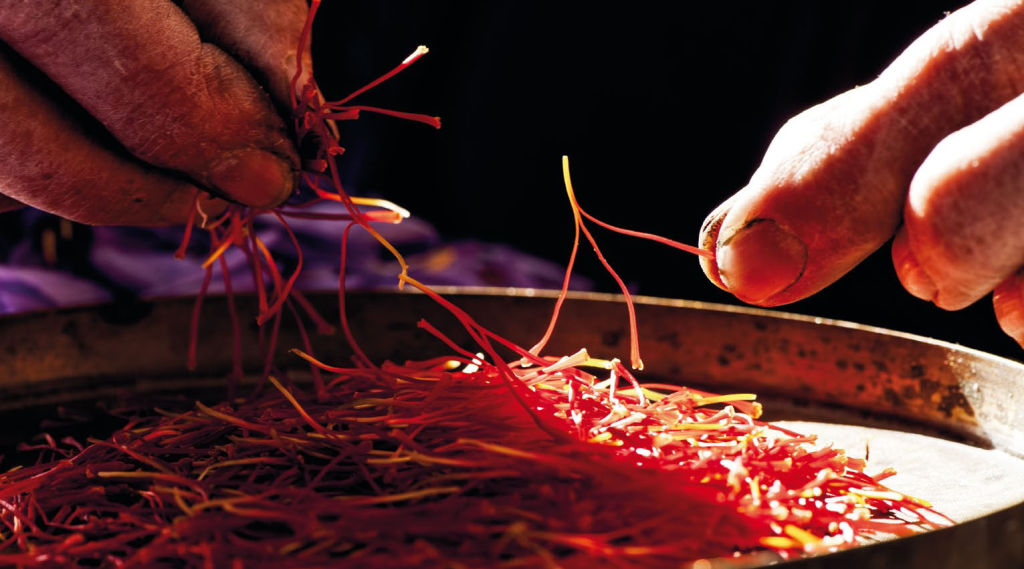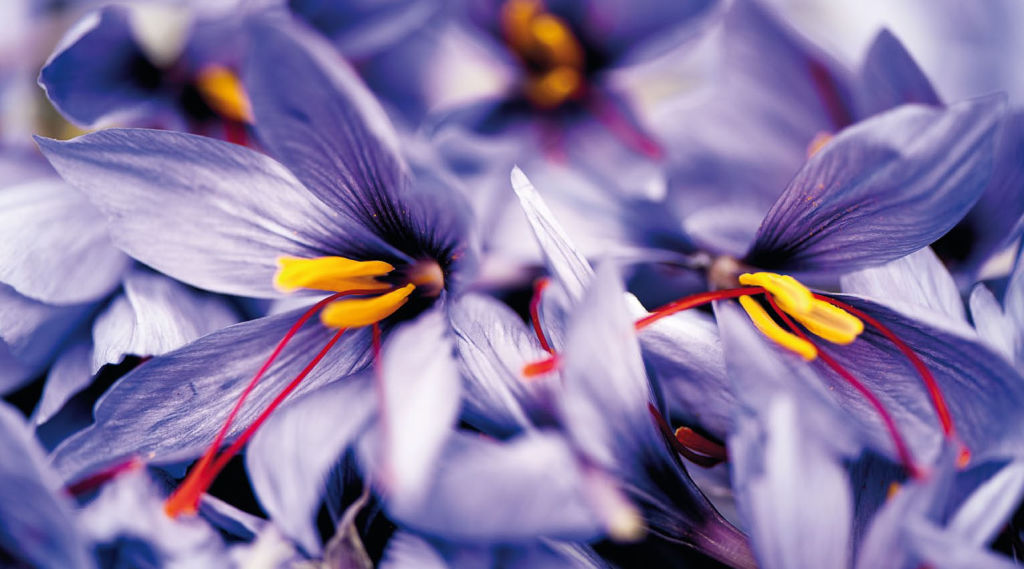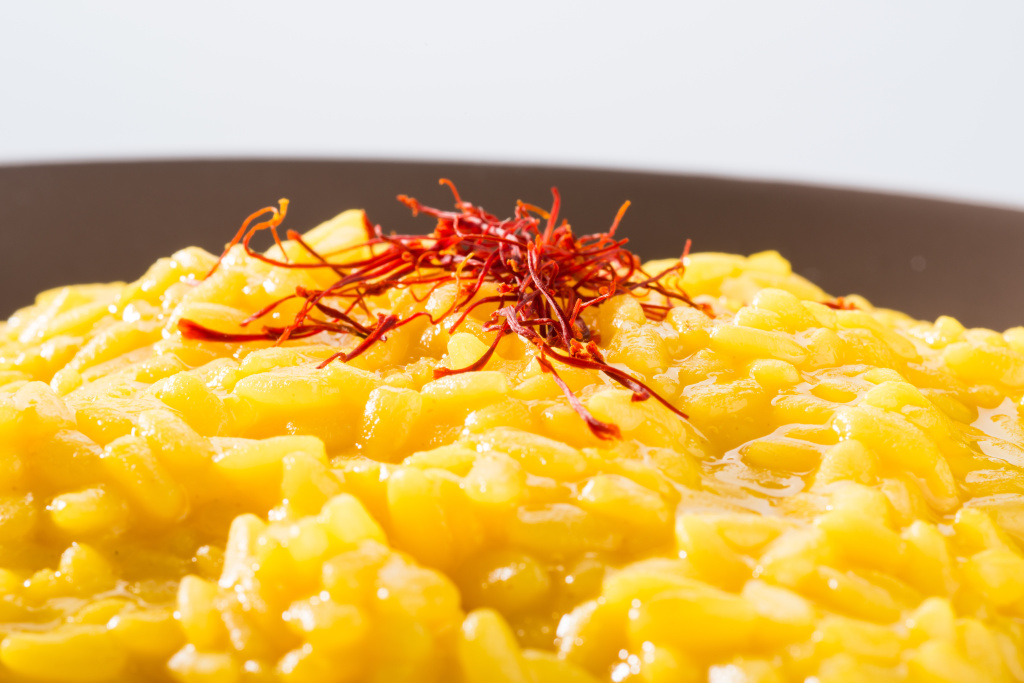 An unparalleled fragrance and colour. L’Aquila saffron contains more than 150 volatile substances, thanks to which it offers its flavour and scent. It is used in both Iberian and Middle Eastern cooking and is the key to success for many traditional regional Italian dishes, especially rice. One of the famous examples is ‘risotto with saffron’, whose colour is due to this ingredient. Among the most appreciated recipes for which saffron is used: tagliatelle with vegetables, gnocchi flavoured with a simple tomato sauce, couscous, as well as roasts, especially both chicken and lamb. Its use for cooking fishes, especially fat fishes, such as salmon and mussels, is a recent creation and a big international success.
An unparalleled fragrance and colour. L’Aquila saffron contains more than 150 volatile substances, thanks to which it offers its flavour and scent. It is used in both Iberian and Middle Eastern cooking and is the key to success for many traditional regional Italian dishes, especially rice. One of the famous examples is ‘risotto with saffron’, whose colour is due to this ingredient. Among the most appreciated recipes for which saffron is used: tagliatelle with vegetables, gnocchi flavoured with a simple tomato sauce, couscous, as well as roasts, especially both chicken and lamb. Its use for cooking fishes, especially fat fishes, such as salmon and mussels, is a recent creation and a big international success.
L’Aquila saffron, that is a little spice, a little ingredient, is the finished product of a long working, from bulb, to flower, and stigma, up to the precious powder. This is a craft activity, where hands are the essential tool for obtaining this excellence. It is impossible to describe the aroma of saffron. Chemists, cooks, experienced gastronomists tried to identify the secret thanks to which the L’Aquila saffron is the most appreciated one, but the opinions are different and the consumers just wish the guarantee that every time they use this mountain spice the excellent result will be always the same.
A unique aroma all over the world
 L’Aquila saffron has been cultivated for almost a millennium in this corner of Abruzzo, especially in the ‘piana of Navelli’, a land between the municipalities of Civitaretenga and Navelli. The area where it is cultivated is a mountain place that faces the Adriatic, characterized by a rough beauty for which it is possible to use superlatives only. It is the spice that is cultivated at the highest level in Europe. The uniqueness of saffron continues in botanical history, too: as it is a sterile plant, that reproduces by means of bulbs, it is considered as a living fossil, because it has always the same genetic code. This product was acknowledged as a DOP (Protected Denomination of Origin) by European Union.
L’Aquila saffron has been cultivated for almost a millennium in this corner of Abruzzo, especially in the ‘piana of Navelli’, a land between the municipalities of Civitaretenga and Navelli. The area where it is cultivated is a mountain place that faces the Adriatic, characterized by a rough beauty for which it is possible to use superlatives only. It is the spice that is cultivated at the highest level in Europe. The uniqueness of saffron continues in botanical history, too: as it is a sterile plant, that reproduces by means of bulbs, it is considered as a living fossil, because it has always the same genetic code. This product was acknowledged as a DOP (Protected Denomination of Origin) by European Union.
Only glass and paper for packaging
As aroma is the heart of this spice, glass receives at its best the stigmas coming from the land of L’Aquila. The paper packaging designed for export, too, are elegant: the simplicity of their logos remind the simplicity of these lands. The very high production technology of these packaging, that must preserve for a long time both aromas and colouring ability, contrasts with their naïve pictures. For L’Aquila saffron, sold either powdered or in integral thread and filaments, there is no plastic. The packaging considers the requirements of dry preservation, far from heat sources and sunshine. For this reason, both glass and paper are adapted to saffron.
 Serves 4: 360 gr. rice; 2 small shallots or half an onion; 150 gr. butter and 50 gr. Parmesan cheese; 1 glass dry white wine; ½ gr saffron threads and 1 x 10 cgr packet; stock. Finely chop scallions or onion and sautè in pan with 100 gr. butter. Add rice (if possible Carnaroli) and toast. Add wine and leave to evaporate. Gradually add hot beef or veal stock stirring regularly till almost cooked. When there is still one minute to go adjust salt and add saffron threads and powder. Add remaining butter and grated Parmesan cheese and mix well.
Serves 4: 360 gr. rice; 2 small shallots or half an onion; 150 gr. butter and 50 gr. Parmesan cheese; 1 glass dry white wine; ½ gr saffron threads and 1 x 10 cgr packet; stock. Finely chop scallions or onion and sautè in pan with 100 gr. butter. Add rice (if possible Carnaroli) and toast. Add wine and leave to evaporate. Gradually add hot beef or veal stock stirring regularly till almost cooked. When there is still one minute to go adjust salt and add saffron threads and powder. Add remaining butter and grated Parmesan cheese and mix well. The Consortium
The Consortium that safeguards the L’Aquila saffron, marking precisely the boundaries of its production area, arrives from such a land of historic cookery traditions as Abruzzo. Almost ten years of national and international presence in order to promote this spice, that is considered as vermilion gold of these mountains. Thanks to saffron, these areas have been able to let know their products all over the world, so changing a rural economy in a solid history of success and flavour.
Credit photo: “ZAFFERANO ZAAFRAN” by Luciano D'Angelo and Sandro Visca
